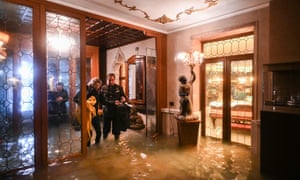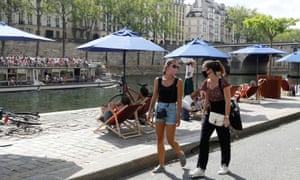Two people die as Venice floods at highest level in 50 years
‘This is result of climate change,’ says Venice mayor, who declares state of emergency
Two people have died as the highest water levels for more than 50 years caused hundreds of millions of euros of possibly irreparable damage in Venice, officials have said, with another surge expected to cause further flooding.
Flood levels in the lagoon city reached the second-highest level since records began in 1923 as a result of the acqua alta, which hit 1.87 metres (74in) late on Tuesday night amid heavy rain, just short of the record 1.94 metres measured in 1966.
Another deluge engulfed the city on Wednesday morning, causing the acqua alta, or high water, to reach 1.60 metres. Most of the water had receded by the afternoon, but residents are bracing themselves for more to come as forecasts predicted high tides of 1.20 metres late on Wednesday night and 1.30 metres on Thursday morning.
An elderly local man from Pellestrina, one of the many islands in the Venetian lagoon, died when he was struck by lightning while using an electric water pump, the fire brigade said. The body of another man was found in his home.
More than 85% of Venice was flooded, authorities said, including the historic St Mark’s basilica. While the water level dropped slightly on Wednesday morning, a further torrent of water, whipped up by high winds, is forecast to sweep in later in the day, reaching a level of 1.60 metres.
The mayor of Venice, Luigi Brugnaro, said he would declare a state of emergency, adding that the flood levels represented a wound that would leave indelible marks. “We ask the government to help us. This is the result of climate change,” he said, putting the damage in the hundreds of millions of euros.
Italy’s minister of culture, Dario Franceschini, said the government would provide an as-yet unspecified amount of funding to help preserve the Unesco world heritage site.
Venice sits on thousands of wooden piles driven into the mud, but rising sea levels and heavy cruise ship traffic have steadily eaten away at the surrounding marshes and mudbanks, causing the city to gradually sink.
St Mark’s Square was submerged by more than one metre of water, while the adjacent basilica was flooded for only the sixth time in 1,200 years – but the fourth in the last two decades. The last occasion, in November 2018, caused an estimated €2.2m (£1.9m) of damage.
The archbishop of Venice, Francesco Moraglia, said St Marks had suffered “structural damage, because the water has risen. This is causing irreparable harm, especially – when it dries out – in the lower section of the mosaics and tiling.”
Carlo Alberto Tesserin, who heads the team responsible for managing the historic site, told Agence-France Presse the water had surged into the basilica with a force “never seen before, not even in the 1966 flood”.
Warnings about potential damage from increasingly high tides “went unheeded”, Tesserin said, adding: “The damage we see now is nothing compared to that within the walls. The salt enters the marble, the bricks, everywhere.”
The governor of the Veneto region, Luca Zaia, described a scene of “apocalyptic devastation”, saying the city was “on its knees”.
“The art, the basilica, the shops and the homes, a disaster … Venice is bracing itself for the next high tide,” he said.
Brugnaro also pledged that the multibillion-euro Mose project, designed in 1984 to protect Venice from high tides but still not in operation, would be completed. Work began in 2003 but has been dogged by delays and myriad issues, including a corruption scandal that emerged in 2014.
The head of the Venice hotels association said the damage was enormous, with many hotels losing electricity and lacking pumps to remove water. Tourists with ground floor rooms had to be evacuated to higher floors as the waters rose on Tuesday night, Claudio Scarpa told the Ansa press agency.
The coastguard provided extra boats to serve as water ambulances. Tables and chairs set out for aperitifs bobbed along flooded alleyways in the dark, as locals and tourists waved aloft umbrellas, the water slopping over the top of waders and wellies.
Water taxis attempting to drop people off at the historic hotels along the Grand Canal discovered that gangways had been washed away, and had to help passengers clamber through windows.
At the sumptuous Gritti Palace, which has played host to royals and celebrities over the decades, including Ernest Hemingway, Elizabeth Taylor and Richard Burton, the bar was largely underwater. Rich tapestries were piled on to tables, while the waters lapped around velvet sofas and leatherbound books.
Two French tourists said they had “effectively swum” after some of the wooden platforms placed around the city in areas prone to flooding overturned.
The overnight surge also triggered several fires, including one at the International Gallery of Modern Art Ca’ Pesaro. Video on social media showed deep water flowing like a river along one of Venice’s main thoroughfares.
Other footage showed large waves hammering boats moored alongside the Doge’s Palace and surging over the stone sidewalks. Much of Italy has been pummelled by torrential rainfall in recent days, with widespread flooding, especially in the southern heel and toe of the country.
Further bad weather is forecast for the coming days.
82 days to save the Earth …
… we’re all in. Are you? On November 4, a day after the presidential election, the US will formally withdraw from the Paris agreement on constraining global heating. It’s urgent that we tell the world what this means, and the Guardian is pulling out all the stops to do so. Will you help us by supporting our journalism?
Millions are flocking to the Guardian every day. Financial support from our readers is crucial in enabling us to produce open, fearless, independent reporting that addresses the climate emergency. It helps sustain the freedom we have to present the facts comprehensively, explain the details as they unfold, and interrogate the decisions made.
The Guardian recognises the climate emergency as the defining issue of our times. That’s why we have pledged to give climate change, wildlife extinction and pollution the sustained attention and prominence they demand, as a core part of our journalism.
At this pivotal moment for our planet, our independence enables us to always inform readers about threats, consequences and solutions based on scientific fact, not political prejudice or business interests. This makes us different. And we are equally determined to practice what we preach: we have divested from the oil and gas sectors, renounced fossil fuel advertising and committed to achieving carbon neutrality by 2030.
We believe everyone deserves access to information that is fact-checked, and analysis that has authority and integrity. That’s why, unlike many others, we made a choice: to keep Guardian reporting open for all, regardless of where they live or what they can afford to pay. Our work would not be possible without our readers, who now support our work from 180 countries around the world.
Every reader contribution, however big or small, is so valuable for our future. Support the Guardian from as little as $1 – and it only takes a minute. Thank you.









Nenhum comentário:
Postar um comentário